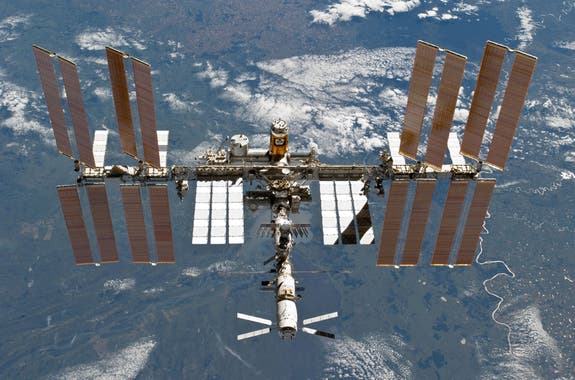
The International Space Station as photographed by an STS-133 crew member on space shuttle Discovery. (c) NASA
Remarkably, a growing issue NASA scientists face everyday is space junk – tiny bits of scrap, bolts, rocket modules from launches and so on. All of them along the years have amassed to a point where it is now very dangerous for satellites, orbiting spacecrafts and especially the International Space Station to freely orbit Earth.
It’s enough to keep in mind that most space debris travel at 18,000 mph, so even a bolt sized junk if it hits the space station at relative speed would be enough to blow it to smithereens. Apparently, such a case wasn’t too far from reality earlier today, when NASA issued a red alert for the ISS as a piece of debris from the Chinese FENGYUN 1C satellite destroyed in an anti-satellite missile test by China in 2007 came critically close.
Approaching the space station from the front, NASA officials said the satellite debris flew within about 3.3 miles (5.3 kilometers) during its closest approach to the space station at 4:21 p.m. EDT (2021 GMT). For the three astronauts on board, American Catherine (Caty) Coleman, Italian Paulo Nespoli, and Russian Commander Dmitry Kondratyev, the situation was tensed, as they were advised to take shelter in “the Russian lifeboat”, the Soyuz capsule that’s attached to the station that could fly them back to Earth. Usually the alert is dropped as the debris gets close enough for NASA to project an exact path, and determines it’s going to miss. The last time debris got close enough to force an evacuation was in 2009.
“Tracking data now indicates that a piece of orbital debris being monitored by Mission Control Houston will not pass close enough to the International Space Station to warrant the Expedition 27 crew members taking safe haven within their Soyuz TMA-20 spacecraft,” NASA officials said in an afternoon status update.
NASA has a very elaborate space junk tracking system, which predicts whether the debris will fly within a preset “pizza-box”-shaped safety perimeter of the ISS – about 15 miles (25 km) around the space station and about a half-mile (0.75 km) above and below the orbiting lab. Even so, however, space junk is getting ever thicker, and consequently situations like these will happen more often.
As of July 2009, more than 19,000 pieces of space debris larger than 10 cm were known to be circling the Earth, according to NASA researchers who track it. Another 500,000 pieces are between 1 cm and 10 cm. The tiniest pieces number in the millions. One of the best solutions to this demanding space issue is the development of a huge space junk laser which would pull debris off course into the atmosphere, but it could take years and years for it to actually get built.









